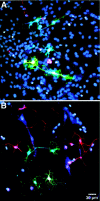The adult substantia nigra contains progenitor cells with neurogenic potential
- PMID: 12151543
- PMCID: PMC6758128
- DOI: 10.1523/JNEUROSCI.22-15-06639.2002
The adult substantia nigra contains progenitor cells with neurogenic potential
Abstract
In Parkinson's disease, progressive loss of dopaminergic neurons in the substantia nigra pars compacta (SN) leads to debilitating motor dysfunction. One current therapy aims at exogenous cellular replacement of dopaminergic function by transplanting fetal midbrain cells into the striatum, the main projection area of the SN. However, results using this approach have shown variable success. It has been proposed that cellular replacement by endogenous stem/progenitor cells may be useful for therapeutic interventions in neurodegenerative diseases, including Parkinson's disease. Although it is widely accepted that progenitor cells are present in different areas of the adult CNS, it is unclear whether such cells reside in the adult SN and whether they have the potential to replace degenerating neurons. Here, we describe a population of actively dividing progenitor cells in the adult SN, which in situ give rise to new mature glial cells but not to neurons. However, after removal from the SN, these progenitor cells immediately have the potential to differentiate into neurons. Transplantation of freshly isolated SN progenitor cells into the adult hippocampus showed that these cells also have a neuronal potential under in vivo conditions. These results suggest that progenitor cells reside in the adult SN and can give rise to new neurons when exposed to appropriate environmental signals. This developmental potential of SN progenitor cells might be useful for future endogenous cell replacement strategies in Parkinson's disease.
Figures







References
-
- Altman J, Das GD. Autoradiographic and histological evidence of postnatal hippocampal neurogenesis in rats. J Comp Neurol. 1965;124:319–335. - PubMed
-
- Araque A, Carmignoto G, Haydon PG. Dynamic signaling between astrocytes and neurons. Annu Rev Physiol. 2001;63:795–813. - PubMed
-
- Bayer SA. Changes in the total number of dentate granule cells in juvenile and adult rats: a correlated volumetric and 3H-thymidine autoradiographic study. Exp Brain Res. 1982;46:315–323. - PubMed
-
- Bjorklund A, Lindvall O. Cell replacement therapies for central nervous system disorders. Nat Neurosci. 2000;3:537–544. - PubMed
-
- Cameron HA, McKay RD. Adult neurogenesis produces a large pool of new granule cells in the dentate gyrus. J Comp Neurol. 2001;435:406–417. - PubMed
Publication types
MeSH terms
Substances
Grants and funding
LinkOut - more resources
Full Text Sources
Other Literature Sources
Medical
Miscellaneous
